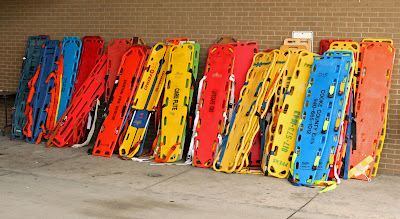
Picture credit from Voodoo Medicine Man.
Continuing to review the presentations I attended at EMS Expo. Jim Morrissey covers spinal immobilization and the way they are eliminating conventional spinal immobilization (placing a rigid collar on the neck and strapping the patient to a board) in Alameda County.[1] Alameda County’s medical director, Dr. Sporer, has an article about the reasons for changing the protocol.[2] Attend his presentations if you have the opportunity.
Oakland is the largest city and they have plenty of experience with trauma, so this will be an important place for EMS to watch to see the rate of spinal disability drop.
Where is the evidence
that spinal immobilization
improves the outcome
of patients?
Even Dr. Dave Ross, who has written some articles critical of spinal clearance protocols, is calling for a study to find out the actual effect of spinal immobilization, because right now there is no good evidence of benefit.[3]
None.
Yes, there are anecdotes of manipulation leading to worse outcomes.
Spinal immobilization is manipulation – no matter how much we try to pretend otherwise.
Do we sedate combative patients in order to immobilize them without added manipulation?
If we do not, then their movements fighting immobilization are producing much greater stress on any unstable spinal fractures that they have.
Dementia – I transported a patient with altered mental status and a fall, who would not tolerate being placed flat on a board. The smallest size on the C-collar was still too large to not place significant distracting force on the neck of this very little little old lady.
She had a C2 (2nd Cervical vertebra) fracture.
Would she be paralyzed if I had forced immobilization on her?
Maybe. Maybe not.
Would I have been able to get orders for sedation of a change in mental status patient to immobilize her?
Maybe she would have survived immobilization without the immobilization increasing her injury.
Maybe. Maybe not.
We will never know.
What we do know is that she was fine with gentle transport, sitting up on the stretcher, without any forced manipulation of her injury to “immobilize” her.
She was fine when I dropped her off. She was fine hours later when I asked about the cause of her change in mental status and found out about the C2 fracture.
What if somebody sues?
A judge should throw out a law suit for a lack of evidence of harm caused by the lack of manipulation.
We need to stop claiming that manipulating the necks of patients is protecting them from injury.
According to spinal clearance criteria, altered mental status is one of the reasons we must not clear the spine.
If these patients do have spinal injuries, in what way do they benefit from the increased stress on the injury provided by EMS immobilization?
Spinal immobilization does not prevent stress on the injury, but only allows us to pretend it is not happening and that we are not causing the injury.
I will look at what they will be doing in Part II.
–
Footnotes:
–
[1] Stop the Madness! Reducing Unnecessary Spinal Immobilizations in the Field
Nov 2 2012 9:30AM
Room: 206
Category: General
Jim Morrissey, MA, EMT-P
Friday Conference schedule.
A mounting body of evidence shows that the current approach to spine injury assessment and treatment needs to change, and change radically. Several studies show that EMS is immobilizing far too many patients and may be causing more harm than good in some trauma victims. This presentation examines the inaccuracy of using mechanism of injury as a predictor of injury and how EMS textbooks and past guidelines have led us astray. We review several articles and papers showing the detrimental effects of immobilizing victims of penetrating trauma and other patients, and discuss the multitude of problems associated with cervical collars and backboards. We review and validate several models of spine injury assessment protocols, especially ones that can reliably clear patients from the need for spinal protection. Finally, we will evaluate tools appropriate for patients who do require some degree of spinal protection.
–
[2] Why We Need to Rethink C-Spine Immobilization
By Karl A. Sporer, MD, FACEP, FACP
Created: November 1, 2012
EMS World
Article
–
[3] Confessions of a recovering field spine clearance addict — revisited
November 02, 2012
By Dave Ross
EMS1.com
Article
Revisiting the article below –
Confessions of a recovering field spine clearance addict
September 06, 2012
By Dave Ross
EMS1.com
Article
I commented on that article in the link below –
Confessions of a recovering cervical spine field clearance addict – Part I
Mon, 10 Sep 2012
Rogue Medic
Article
I have not yet written Part II.
.


Rogue, I just became a member of our regional trauma association’s performance improvement committee where I get to track data retrospectively. I’m wondering if adding a question or two to our data set would be helpful for this. Any suggestions? I’m thinking of asking whether or not the patient was immobilized, how they were immobilized, whether there was a spinal injury, and if so, if there was neurological deficit. I’d love to get your input on this.
Simply a ring under the head and or sand bags on both sides are very useful and least discomfort to a suspected spinal injury patient
Except if the sandbags move. If there is an unstable spinal injury, the sandbag movement may complete the damage.
There is also no valid evidence of benefit with this method.
.